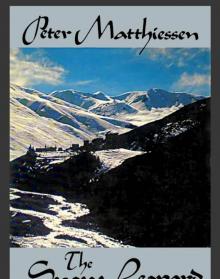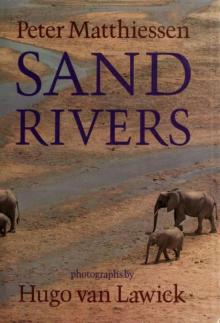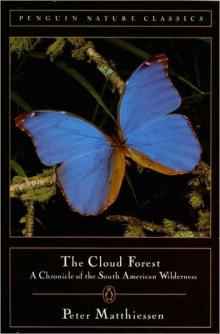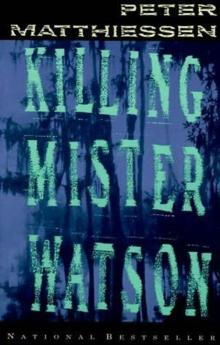- Home
- Peter Matthiessen
The Cloud Forest
The Cloud Forest Read online
Contents
Cover
About the Book
About the Author
Also by Peter Matthiessen
List of Illustrations
Dedication
Title Page
PART I
1. Sargasso Sea and Southward
2. Amazonas
3. Sierra
4. Tierra del Fuego
Notes on the Cities
5. Mato Grosso
PART II
6. Beyond Black Drunken River
Epilogue
Picture Section
Acknowledgments
Index
Copyright
About the Book
Peter Matthiessen has long been known for his travels to some of the remotest lands on earth, most notably recorded in The Snow Leopard. The Cloud Forest brings to vivid life a South American journey that took him from the Sargasso Sea to the jungles of Amazonia, from the Inca city of Machu Picchu high in the Andes to the bleak rocks of Tierra del Fuego and the winds and vast skies of Patagonia. The result is an incisive and marvellously well-observed journal by a born writer and naturalist, a voyage of exploration among the people, places and fading wildlife of this most exotic and mysterious of continents.
About the Author
Peter Matthiessen, naturalist, explorer, novelist, was born in New York City in 1927 and graduated from Yale University in 1950. He also attended the Sorbonne and, in the 1950s, co-founded the Paris Review. He worked for three years as a commercial fisherman on the ocean haul seine crews at the eastern end of Long Island, and as a captain of a charter fishing boat. His many expeditions to the wilderness areas of the world have taken him to Alaska, the Canadian Northwest Territories, Asia, Australia, Oceania, South America, Africa, New Guinea and Nepal – memorably described in such books as Under the Mountain Wall, Blue Meridian, Sand Rivers, The Tree Where Man Was Born (with Eliot Porter), African Silences and, above all, The Snow Leopard. Peter Matthiessen has also written eloquently of the fate of the North American Indians in Indian Country and In the Spirit of Crazy Horse, and he is the author of several novels, including. At Play in the Fields of the Lord and Far Tortuga, and of the acclaimed short story collection On the River Styx. His most recent novel is Killing Mister Watson. Peter Matthiessen lives in Sagaponack, Long Island, New York State.
Also by Peter Matthiessen
Fiction
RACE ROCK
PARTISANS
AT PLAY IN THE FIELDS OF THE LORD
FAR TORTUGA
ON THE RIVER STYX
KILLING MISTER WATSON
Non-fiction
WILDLIFE IN AMERICA
UNDER THE MOUNTAIN WALL
THE SHOREBIRDS OF NORTH AMERICA
SAL SI PUEDES
THE WIND BIRDS
BLUE MERIDIAN
THE TREE WHERE MAN WAS BORN
(with Eliot Porter)
THE SNOW LEOPARD
IN THE SPIRIT OF CRAZY HORSE
SAND RIVERS
INDIAN COUNTRY
NINE-HEADED DRAGON RIVER
MEN’S LIVES
AFRICAN SILENCES
Illustrations
Amazonas
M.S. Venimos loading grain meal (Gonaïves Gulf, Haiti)
Pucallpa waterfront, Ucayali River (Peru)
River settlement at Belén, near Iquitos (Peru)
On the Napo River
“Crying God,” Tiahuanaco ruins (Bolivia)
Aymara woman (Bolivia)
Quechua Indians of the sierra (Bolivia)
Andean lake (Peru)
Inca ruins at Sacsahuaman (Peru)
Quechua market, Pisac (Peru)
Strait of Magellan and Tierra del Fuego (Chile)
Sheep range, Tierra del Fuego (Argentina )
Beagle Channel and Hoste Island, Tierra del Fuego (Argentina)
Hidden Lake and Lake Fagnano, Tierra del Fuego (Argentina)
Caraja encampment, Araguaia River (Brazil)
Caraja canoes, Araguaia River (Mato Grosso in background)
Caraja boy
Caraja ritual costume
Old woman bathing, Araguaia River
The upper Urubamba, from ruins at Machu Picchu
Hacienda Marquez, on Yanatili River (Black Drunken River)
The cloud forest at El Encuentro
Andrés Porras and his friend Señor Antonio Basagoitia
Ardiles
Epifanio Pereira at Sangianarinchi
Toribio
Construction of balsa raft, Pangoa
Machiguenga campfire
Agostino
Mouth of the Pongo, lower end
Dawn on the Urubamba
Last resting place of the Happy Days, Timpia
Machiguenga chief, Timpia
Machiguenga woman, Camisea
Campa woman, Inuya River
Campa hunters and drying arrow shafts
Indian encampment, Inuya River
Quebrada Grasa
César Cruz and author, with mandíbula, Mapuya River
Mission Conibos, Ucayali River
The fossil in police yard, Pucallpa
The fossil in police yard, Pucallpa
1. Map of the Urubamba-Ucayali
2. Map of the Mapuya region
For
Andrés Porras Cáceres
My excellent friend and mentor on the Urubamba, whose wiser head prevailed.
And for
Lucha and Alfredo Porras Cáceres
Whose kind welcome in Lima and at La Honda,
in January, March and May,
made so much difference.
Peter Matthiessen
THE CLOUD FOREST
A Chronicle of the South American Wilderness
1
Sargasso Sea and Southward
November 20.
A PALE NOVEMBER sky, like a sky on the moon. The M.S. Venimos is scheduled to sail at three p.m., but freighters rarely leave anywhere on time, and it is 20:32 in the evening by the ship’s clock when a stevedore on the Brooklyn pier lets the last hawser slap into the water. “All gone aft,” he bawls—incongruously, for he is wearing a fedora—and shoves his hands into his pockets. There is a nine-mile wind out of the northwest, sharp as ice. The man retraces his steps along the darkened pier without glancing at the ship again. She is warped swiftly from her berth by the tug Isabel A. McAllister, which remains fastened alongside until the ship has cleared the Erie Basin. To starboard lies Governor’s Island, and behind it the bright night walls of Manhattan, soaring up out of the black harbor like the Seven Cities of Cibola.
Now the tug is gone, and there comes a sense of uncertainty, of loss. This is not entirely homesickness; a continuity has been broken with the desertion of that tug, as if life must now start up all over again. On a long journey the first port left behind is the memorable one, and the sense of parting cannot help but be intensified by the scope and light of New York Harbor after dark as seen from the stern of a ship sliding outward toward the Narrows. Nearby a bell buoy rings quietly, the sound strangely penetrating against the night sounds of the city.
Staten Island looms to starboard, and to port the shore parkway flickers along Gravesend Bay. The green, red, and white running lights of harbor craft, and night fires on the Jersey shore. The Venimos sounds two blasts of her whistle: a larger ship is overtaking and passes finally to port. In the outer harbor other freighters, anchored, hang suspended on the faint reflections from the shore.
9:45. The lights of Brooklyn widen, fall astern, and the Jersey lights stretch out, marking off great areas of blackness. We are nearing Sandy Hook.
The Narrows, Gravesend, Sandy Hook, the Ambrose Lightship, the Atlantic—wonderful names, sea na
mes. The night sky overcast, and the night wind damp and raw. Even before I fell asleep the ship had commenced that subtle quake which meant that the long swells of the open sea had taken hold of her. She is bound up the Amazon for Peru by way of Bermuda, the Sargasso Sea, the Windward Islands and Barbados, Trinidad, British Guiana, and Brazilian ports along the river. My own destination is less precise—the rain forest and the Andean sierra, Mato Grosso and Tierra del Fuego. The very names evoke so much, and are their own justification for this journey, for one must hurry if one is still to glimpse the earth’s last wild terrains. The greatest of these, the oceans and Antarctica excepted, lie not in Africa but within the mysterious continent of South America.
November 21.
At eight this morning, over one hundred miles from land, there were ten herring gulls still with us, and at nine-thirty there were, astonishingly, three times that many. The birds sail forward on the ship’s air currents, coast across the cargo booms on the long foredeck, and slide away astern, where they stroke along resignedly in the wake. It interests me that all of them are birds in their second year, not yet in full adult plumage—as if the adults knew when and where to gain their living more easily. Undoubtedly the new birds were attracted to our wake by breakfast slops, but where they could have come from is a mystery, unless we drew them from some passing ship where the pickings had proved lean. I saw no ship, however, and I have been on deck all morning; while a gull’s vision is considerably better than my own, it cannot see over the horizon.
The water is turning a deep blue, with an increase in chop though the wind is steady, as if we were entering the Gulf Stream. But there are no signs as yet of the Gulf Stream’s floating weed, and the air remains quite cold.
The Venimos rolls smoothly through the chop, by all signs an able ocean-going vessel. She is a small freighter of 1308 gross tons, built in Hamburg in 1956, her registered home port Hamilton, Bermuda. Her length is 265 feet, hull gray, superstructure white. The crew is twenty-five in number—thirteen Brazilian seamen, three Peruvian stewards, a chief engineer who is Welsh, and two Scots engineers (the Malays and Lascars hatching dark, mutinous stratagems in the fo’c’sle may be missing—indeed, the fo’c’sle itself is missing; the crew is quartered below decks in the poop house aft—but surely the Scotsmen in the engine room are in the grand old tradition of British seafaring); the captain, three mates, radio officer (known as “Sparks,” of course), and fourth engineer are English. There are two passengers besides myself: a missionary of the New Tribes Mission, returning to the Brazilian interior, and a Lebanese with a Turkish passport, journeying to Belém on business. Both are agreeable companions, though the latter sleeps most of the day. In fair weather he appears now and then on deck, garbed in bazaar blues and yellows and black harem slippers. Truly he is the ageless merchant of the Levant, tired and tireless, homeless and resigned, probing the world on his joyless caravanserai.
The wind has freshened all day long and is now coming out of the southeast at over twenty-five miles per hour. This is a crosswind on the Gulf Stream, which we entered in mid-afternoon, and in consequence the sea has become rough. The sky, dimly overcast all day, with cirrus clouds in heavy ranks on the horizon, is austere and ominous with its signs of changing weather—and weather change at sea is invariably impressive, the ship seeming to shrink in size under the vast engulfing sky. Some of the gulls have dropped away, whether homeward or to another ship one cannot tell. The rest—I count nineteen at dusk—sweep silently up and down the wake or hang on the sky above the taffrail. Now and then they utter high, small, wintry cries, quite unlike the summer yawps so familiar along the coast. Two pelagic birds appear but keep their distance—a swift jaeger and a great skua, hulking along across the gathering waves.
This is only the first day out, with forty left to go, for a radiogram has come, and the freighter has been rerouted: before proceeding to the Windward Islands she must work west again to Haiti, to take on a cargo of grain meal for Barbados.
November 22.
In the Gulf Stream last night it was very rough indeed. Rain in brief fits, and the roar of the sea drowned out for the first time the drum and mutter of the ship. I slept badly, and around three a.m., when the sky grew strangely light, stood at the porthole for a while watching the gray monsters toiling past.
By morning the herring gulls were gone, and true oceanic birds had appeared out of the wastes to take their place. All came quite close in the light rain, and I was able to identify two young kittiwakes with their lovely wing bands, as well as a number of the so-called “sea hawks”—pomarine jaegers and their larger relatives, a pair of great skuas. These flew about the ship for several hours until about mid-morning, when all vanished. We are nearing the southerly limits of the skua and the kittiwake, and it is not likely that these species will appear again. Already, in fact, a single frantic flying fish—the first semi-tropical creature—has skittered off among the Gulf Stream weed patches.
At 3:50 in the afternoon, on the afterdeck, a starling whirled up from astern and landed on the lifeboat davit. Wherever it may have come from, it cannot be less than four hundred miles from shore (the captain was kind enough to estimate our position at 3:50: 35°27′ north by 67°58′ west), and yet when I approached cautiously to photograph it, it flew off immediately to the westward, toward the mainland. It knows where it is bound, apparently, but where it might have come from is a mystery so strange as to be quite disturbing. I can’t believe it will ever reach the land. . . .
November 23–24. The Bermudas.
During the night we ran into the fringe of a series of gales which stretch, apparently, from southeast of Bermuda as far north as Iceland, and eastward across Europe. The swells from these storms were huge, and after two a.m. I was thrown about in my berth like a sack of custard. The day, when at last it dawned, was clear, and the great sparkling walls of blue water, some of them thirty feet and more, seemed exhilarating rather than otherwise. (Waves larger than that are awesome, however; not only are they not exhilarating, they are oppressive, even to the best of sailors. “They soared by us in broad sombre ranges, with hissing white ridges, an inhospitable and subduing sight,” as H. M. Tomlinson says in The Sea and the Jungle. And: “The mirror of water on the iron surfaces, constantly renewed, reflected and flashed the wild lights in the sky as she rolled and pitched, and somehow these reflections from her polish made the steamer seem more desolate and forlorn.” Conrad himself could not put it better than that.)
The starling mystery has been renewed with the sudden appearance of this tireless bird among the cargo hatches early this morning. There is the remote possibility, of course, that two birds arrived yesterday and only one was fool enough to depart, or even that this one arrived separately, but the chances are that yesterday’s bird took a good hard look at its situation (and if a bird can be hardheaded, it is certainly the squat, quarrelsome starling) and hastened back to the Venimos. In any case, the incumbent seems content to tarry here a while, fluttering busily up and down the ship or diving into a cable drum to rest. It will almost certainly disembark at Bermuda tonight, in quest of food and water. Some of the junior officers have interested themselves in its plight, or interested themselves in my interest—I cannot be sure which seems to them the greater curiosity.
At 10:30 this morning a lone herring gull appeared and as quickly disappeared again, whirled away like a scrap of blown paper. We are now less than one hundred miles from land. I am keeping a weather eye out for the rare cahow, or Bermuda petrel, a bird which was thought extinct for over three hundred years before a few were discovered fifty years ago, still nesting on the islets of Castle Roads. It could appear at any time, but I am not really hopeful.
We arrived at the Bermudas after dark and lay to off the south shore until dawn, when a pilot arrived to take the ship in through the reefs to the town of Saint George’s.
Saint George’s is a pretty old town, and I was interested to note, at Saint Peter’s Church, that the Mr. W. Strac
hey who supplied a vivid account of the “murtherings” of the then very numerous cahow (in his chronicle of the wreck at the Bermudas of the Sea Venture, said to have been the source of inspiration of The Tempest) officiated at Bermuda’s first wedding in 1609.
We left Bermuda in mid-morning, and I spent several hours on the bridge, scanning the waters, but I saw no cahow; as a matter of fact, I saw no sea bird of any description at Bermuda, though several are known to breed there.
Tomorrow is Thanksgiving.
November 25. Sargasso Sea.
The advantage of this small, slow freighter is that its route encompasses not only the great Amazon but that trackless ocean desert known as the Sargasso Sea—though now we have been rerouted and are bearing southwest to Haiti, so that we shall not traverse the place in medias res, as I had hoped, but only its western reaches.
The Sargasso Sea, which we entered late last night, is an amorphous oblong at least 400 by 1000 miles in its dimensions, located approximately in that part of the Atlantic south of Bermuda and south and west of the Azores, or, more precisely, within latitudes 25 to 30 degrees north and longitudes 40 to 70 degrees west. Since it remains strangely isolated, one might almost think of it as a huge island in the mighty ocean rivers which swirl around it—the Gulf Stream to the west and north, the Canaries Current to the east, the Equatorial and the Antilles Currents to the south—all these rivers set in clockwise motion by the earth’s rotation and impelled by the prevailing winds. In the north these are the westerlies, and in the south they are those relentless tropic breezes known as the northeast trades.
The sea is named for Sargassum bacciferum, brown algae with neat clustered bladders; they collect here, according to old accounts, in quantities sufficient to entrap a sailing ship. Like most old accounts, this one is untrue. The general area is known also as the Horse Latitudes, a name which apparently derives from days when ships becalmed in these blue windless fields would be forced to heave live thirsty cargo over the side; the surface of the sea was allegedly littered at times with the bodies of dead animals.

 Lost Man's River: Shadow Country Trilogy
Lost Man's River: Shadow Country Trilogy The Tree Where Man Was Born
The Tree Where Man Was Born The Snow leopard
The Snow leopard Sand Rivers
Sand Rivers The Cloud Forest
The Cloud Forest Sal Si Puedes (Escape if You Can)
Sal Si Puedes (Escape if You Can) Far Tortuga
Far Tortuga Men's Lives
Men's Lives On the River Styx: And Other Stories
On the River Styx: And Other Stories Shadow Country
Shadow Country At Play in the Fields of the Lord
At Play in the Fields of the Lord Lost Man's River
Lost Man's River Killing Mister Watson
Killing Mister Watson On the River Styx
On the River Styx